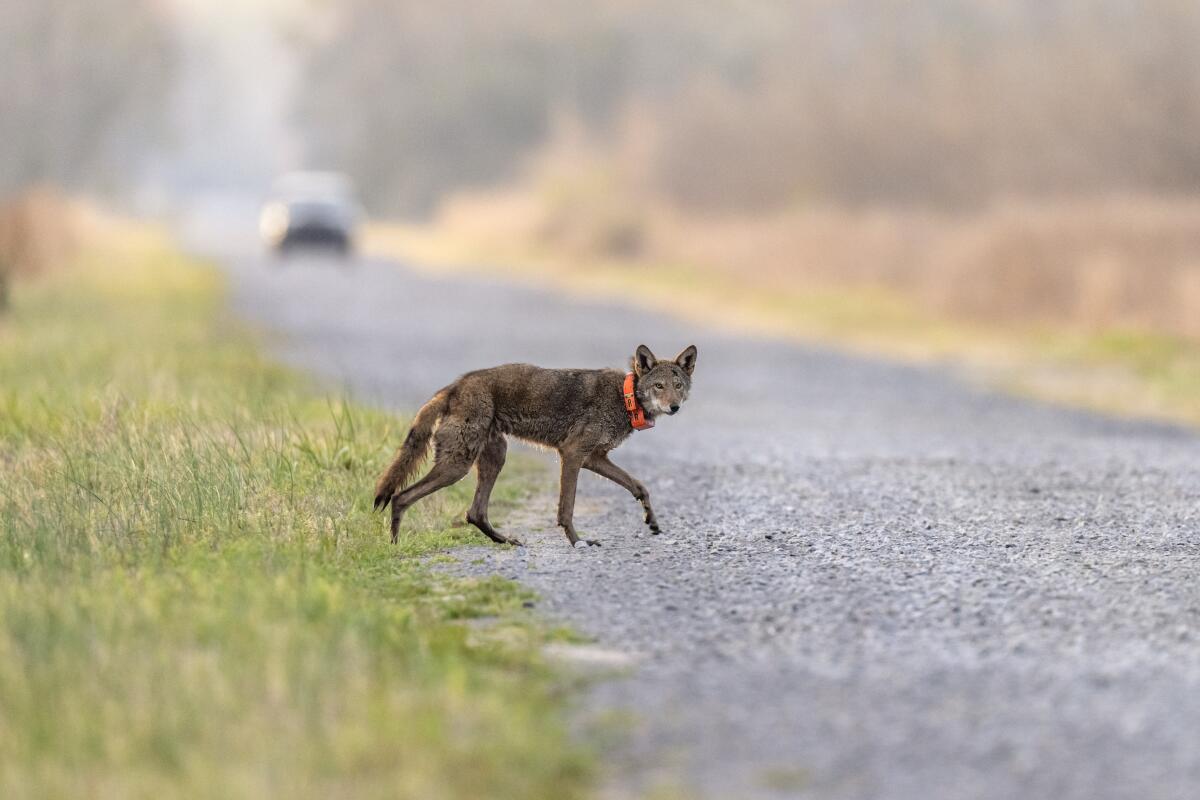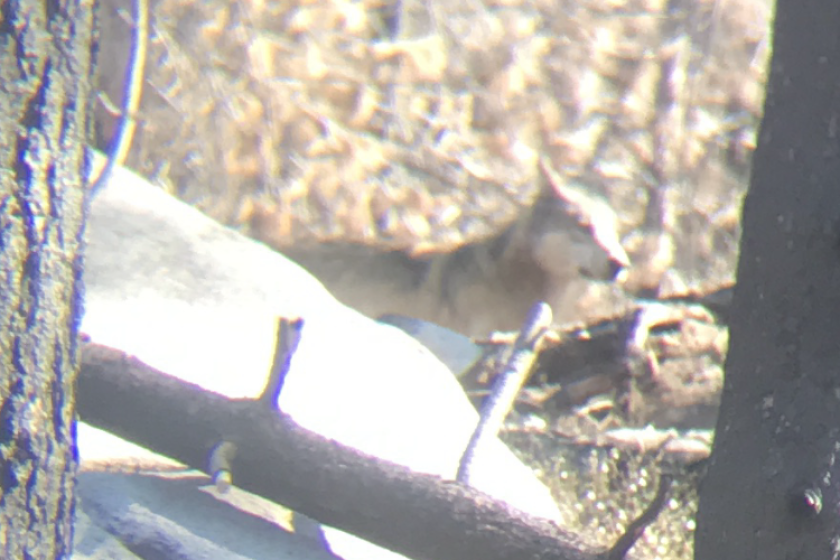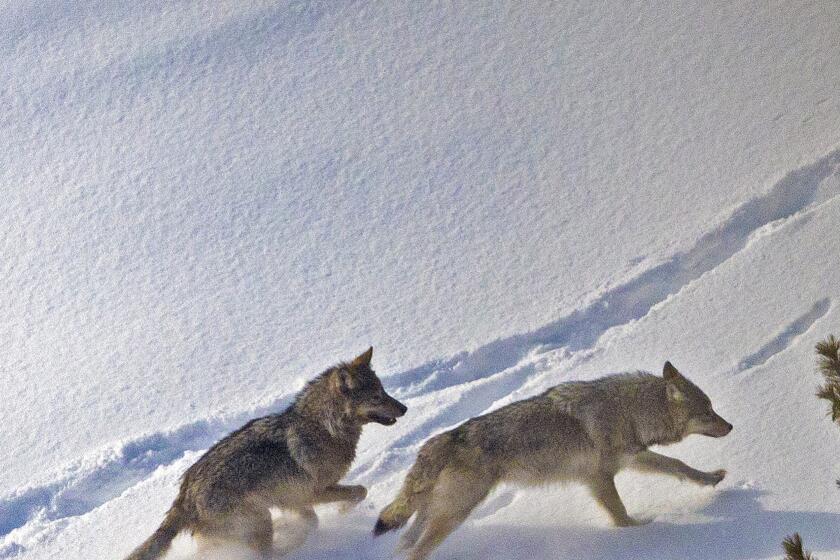Endangered red wolves on the brink of extinction with only 13 left in the wild

- Share via
ALLIGATOR RIVER NATIONAL WILDLIFE REFUGE, N.C. — Jeff Akin had to bite his tongue.
He was chatting with a neighbor about efforts to protect and grow the area’s red wolf population. The endangered wolves are equipped with bright orange radio collars to help locals distinguish the federally protected species from invasive, prolific coyotes.
“If I see one of those wolves with a collar on, I’m going to shoot it in the gut, so it runs off and dies,” Akin says the neighbor told him. “Because if it dies near you, and they come out and find the collar, they can arrest you.”
Akin is a hunter and the walls of his country house are lined with photos of the animals he’s killed. But what he heard made him sick.
“I wouldn’t shoot a squirrel in the stomach if I was hungry,” he says. “It’s just not humane.”
In a way, the anecdote sums up the plight of this uniquely American species.
Once declared extinct in the wild, Canis rufus — the only wolf species found solely in the United States — was reintroduced in the late 1980s on the Alligator River National Wildlife Refuge, just across the sound from eastern North Carolina’s Outer Banks. Over the next quarter-century, it became a poster child for the Endangered Species Act and a model for efforts to bring back other species.
“The red wolf program was a tremendous conservation success,” says Ron Sutherland, a biologist with the Wildlands Network. “It was the first time that a large carnivore had been returned to the wild after being driven extinct, anywhere in the world.”
The sudden appearance of the so-called Tulare Pack in Giant Sequoia National Monument comes with a number of complications, including concerns for livestock.
But the wild population is now back to the brink of oblivion, decimated by gunshots, vehicle strikes, suspected poisonings and, some have argued, government neglect.
For the first time in nearly three decades, the U.S. Fish and Wildlife Service is poised to release an updated recovery plan for the red wolf. According to a draft, the agency proposes spending a quarter-billion dollars over the next 50 years to rebuild and expand the wild wolf population.
“It was done once before,” says Joe Madison, North Carolina manager for the Red Wolf Recovery Program. “And we can do it again.”
But the effort depends heavily on cooperation from private landowners. And the passage of 36 years seems to have done little to soften locals’ hearts toward the apex predator.
Out here, farming and leasing land to hunters are big business. The red wolf is seen by some as competition, and a threat to a way of life on a fragile landscape already imperiled by climate change.
“They don’t belong here!” a woman shouted at agency staff during a recent public meeting on the program.
Add to that a widespread mistrust of government, and the road ahead looks long and perilous for “America’s wolf.” But allies like Akin and Sutherland say they have to try.
“The red wolf, it’s ours,” Sutherland says. “It’s ours to save.”
::
On a recent visit to Alligator River, Madison parks his truck beside a canal, climbs out and hoists an H-shaped antenna into the air. Faint beeps emanate from a radio in his left hand as he slowly swivels from side to side.
“Based on the radio telemetry, there are six red wolves hunkered down in there,” says Madison, motioning to a patch of brush between two cleared farm fields. His bushy red-and-gray beard lends him an uncanny resemblance to his quarry.
That’s roughly half of the world’s total known wild red wolf population.
The red wolf once roamed from central Texas to southern Iowa and as far northeast as Long Island. But generations of persecution, encroachment and habitat loss reduced them to just a remnant clinging to the ragged Gulf coast along the Texas-Louisiana border.
Starting in 1973, the year Congress passed the Endangered Species Act, the last wolves were pulled from the wild and placed in a captive-breeding program.
“By 1980,” Madison says, “they had declared red wolves extinct in the wild.”
Gray wolves are thriving at Isle Royale National Park five years after they nearly died out, but a debate rages over whether they belong there.
But the captive breeding program did so well that, after just a few years, officials felt it was time to try restoring the red wolf to the wild.
They chose Alligator River, a 158,000-acre expanse of upland swamp on North Carolina’s Albermarle Peninsula, not far from Sir Walter Raleigh’s doomed “lost colony” of Roanoke.
The program started in 1987 with four breeding pairs. Five years later, a second group was placed in Great Smoky Mountains National Park — 522,427 acres of forest straddling the North Carolina-Tennessee border.
The inland experiment was ended in 1998, due to “low prey availability, extremely low pup survival, disease, and the inability of red wolves to maintain stable territories within the Park,” the government said at the time.
But with the releases of adults and fostering of captive-born pups into wild family groups, the Alligator River population thrived.
“It was the model for how gray wolves were returned to Yellowstone,” Sutherland says of the Western species, which has since been taken off the endangered list. “And it’s been the model since then for all kinds of rewilding of projects all over the world.”
By 2012, the population in the five-county restoration area reached a peak of about 120 animals. Then the bottom fell out.
Shootings and vehicle strikes were the leading causes of death.
Meanwhile, coyotes moved into the area and began mating with the depleted wolf stock. Around the same time, the North Carolina Wildlife Resources Commission allowed nighttime spotlight hunting of coyotes, which are much smaller, but look similar to red wolves.
In January 2015, the state commission asked Fish and Wildlife to end the program and once again declare the red wolf extinct in the wild. The federal agency suspended releases from the captive population while it re-evaluated the “feasibility” of species recovery.
As climate change heats ocean water around coral reefs, scientists in Florida race to haul coral to safety in gene-bank tanks before they go extinct.
A 2018 species status assessment declared the wild population would likely disappear within six years “without substantial intervention.”
With no new releases, the wild population eventually dipped to just seven known animals.
In 2020, conservationists sued the agency, alleging the suspension of captive releases violated the Endangered Species Act. Releases and pup fostering resumed the following year.
In early August, the agency settled with the groups, promising regular releases from the captive population, which currently stands at around 270, over the next eight years. Meanwhile, a new recovery plan and population viability analysis are due out this fall.
The most recent draft called for spending of more than $256 million over the next 50 years. The red wolf could be delisted by 2072, the agency concluded, providing “all actions are fully funded and implemented” and with “full cooperation of all partners.”
It’s unclear whether the North Carolina wolves have a half century. If Greenland continues to melt at the current rate, the East Coast could see more than 3 feet of sea level rise in the next 50 years, says Jeffress Williams, a senior scientist emeritus with the U.S. Geological Survey. The average elevation at Alligator River: about 3 feet.
“They ought to be factoring that in,” says Williams, who works at the Woods Hole Coastal and Marine Science Center in Massachusetts.
So, the wolves will have to roam farther and farther inland, into more densely populated areas. And that is only going to put them in more competition with what Akin calls the real “apex predator” — Homo sapiens.
::
One of the big complaints is that the wolves will gobble up all the game, especially white-tailed deer, the main food source of Canis rufus.
Although exact numbers for the recovery zone are hard to come by, the wildlife commission says hunting generated $1 billion statewide last year. Recent hunting leases posted online ranged from $861 for a 22-acre property to $3,050 on 167 acres with “everything deer need,” the site boasted.
Sutherland believes fears of “a wildlife disaster” are unfounded, and he’s out to prove it.
The number of endangered Mexican gray wolves roaming the southwestern U.S. has exceeded 200 for the first time since reintroduction efforts began more than two decades ago.
Braving snakes and brushing ticks from his clothes and gear, he kneels beside a pine tree on the Pocosin Lakes National Wildlife Refuge and starts drilling holes. He bolts a wildlife camera about a foot up the trunk.
“The animals the wolves eat, like rabbits and rats and deer and things and species like that, they like this kind of habitat,” he says. “Our job is to document whether this fire break is ... creating more local abundance of these different wildlife species.”
As for the wolves, their numbers are in constant flux.
Two four-pup litters were born in April at Pocosin Lakes, followed in May by five pups at Alligator River. But as of August, Fish and Wildlife said the known/collared wild population was 13, with a total estimated wild population of 23 to 25. That’s down from June, when the numbers were 16 and 32 to 34.
Fish and Wildlife has launched numerous initiatives to cut down on human-caused deaths. Gunshots are top of the list. The wolves are outfitted with orange, reflective collars to make them more visible at night.
“Most hunters and the general public know that bright orange, hunter orange, means, ‘Don’t shoot,’” says Madison.
He also reminds people at public meetings it’s illegal to intentionally kill an endangered wolf that is not threatening humans, pets or livestock. The death must be reported to Fish and Wildlife within 24 hours.
To cut down on road kills, officials have placed flashing signs at both ends of the Alligator River preserve to warn motorists to watch out for endangered wolves and “drive with caution.”
But the biggest hurdle to red wolf recovery is space. The two refuges’ combined roughly 422 square miles of federal land might sound like a lot. But Madison says a single pack’s territory can be as much as 80 square miles.
“There’s not a large enough land mass of public land in the Southeast within the historic range that can fully support a viable red wolf population,” he says. “We’re going to have to rely somewhat on private land for reintroduction.”
That’s where Prey for the Pack comes in.
::
Started in 2020, the program offers landowners incentives to make habitat improvements. The government will reimburse people up to 80% of the cost of thinning woods and planting the kinds of vegetation that will attract the types of prey red wolves prefer, says Luke Lolies, who runs the program.
In exchange, Fish and Wildlife gets access to do such things as install wildlife cameras or come onto their land to capture coyotes. Basically, Lolies says, “They allow red wolves to peacefully live on their property.”
But if a recent public meeting is any indication, Lolies and the wolves are facing an uphill battle A crowd of about 60 braved thunderstorms to gather in the gymnasium of Mattamuskeet High School in Swanquarter, N.C.
They listened politely as Madison and others gave an update on the program. But no sooner had the floor been opened to questions than things got heated.
One man referred to the wolves as a “hybrid predator,” repeating a common belief here that all the animals are now mixed with coyotes. That’s despite a 2019 National Academy of Sciences report confirming the red wolf was a “distinct” and “taxonomically valid” species. Madison noted two hybrid litters were discovered last year and euthanized.
Another concern was safety for humans and animals. There has never been a documented attack by a red wolf on a human, Madison says. And a “depredation fund” set up by the Red Wolf Coalition to reimburse people for animals killed by a wolf has only paid out one claim, coalition director Kim Wheeler says.
A man in a camouflage jacket questioned the program’s costs versus the number of jobs created in the five counties. Another wondered how landowners who make money off hunting would be compensated for game the wolves will eat.
“If you do not get landowner cooperation in the five-county area, will you stop the program?” asked one man, who farms 15,000 acres in the wolf-recovery area.
An exasperated Madison says it wasn’t for him to say.
“We all know what the answer is,” the farmer replies sarcastically. “You just can’t say it out loud.”
Aspen Stalls, who recently started a wildlife guiding business in the area, says the wolves can benefit the local economy, but that’s not the point.
“They have been here for a very, very, very long time, long before us,” says Stalls, who studied canid ecology in college and sports a wolf tattoo on her left arm. “And they are a vital part of keeping this ecosystem balanced.”
The five-county wolf recovery area covers nearly 1.8 million acres. But in three years, Prey for the Pack has managed to sign up only four landowners, for a total of just 915 acres.
Of the four Prey participants, only one agreed to be identified: Jeff Akin.
::
About eight years ago, the retired Raleigh real estate developer built a hunting and fishing getaway on 80 acres (of what he calls “Hyde County thicket: Sucker pines, loblolly pines, wax myrtles and briers.”
“I had to use a machete to walk through it the first time to find the edges,” he says. “Snakes and mosquitoes love it.”
With help from Lolies and his staff, he hopes the wolves will love it, too.
A white sign bolted to a tree along the main road declares Akin a member of “Partners for Fish & Wildlife.” He suspects his neighbors aren’t too happy about it.
Lee Williams, who lives just down the road, can’t believe the government is spending millions of taxpayer dollars to protect what he considers “a mongrel.”
“I never had it around here when I was growing up, and I really didn’t miss it,” the 74-year-old retired state marine patrol officer says. “I didn’t miss a dinosaur and I wouldn’t miss them.”
About a week after the public meeting, a red wolf was found dead along a fence line in neighboring Washington County, shot in the torso.
After witnessing the hostility in the school gym, Akin got together with another wolf supporter to try to develop a better “sales pitch” for fellow landowners.
“We need to break down some resistance to wolf recovery and some existing fears about putting your land in a government program of any kind,” he says.
He knows his 80 acres are just “a drop in the bucket.” But he can’t just do nothing.
“It’s not nature that’s taken the red wolf out,” he says. “It’s us. So, we are the ones to help them get back.”
More to Read
Sign up for Essential California
The most important California stories and recommendations in your inbox every morning.
You may occasionally receive promotional content from the Los Angeles Times.

















